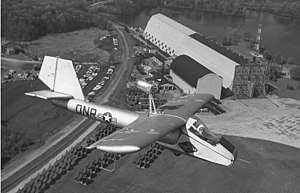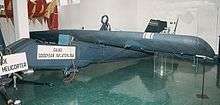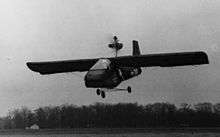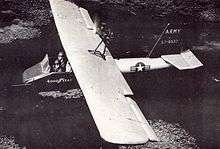Goodyear Inflatoplane
The Goodyear Inflatoplane was an inflatable experimental aircraft made by the Goodyear Aircraft Company, a subsidiary of Goodyear Tire and Rubber Company, well known for the Goodyear blimp. Although it seemed an improbable project, the finished aircraft proved to be capable of meeting its design objectives, although orders were never forthcoming from the military. A total of 12 prototypes were built between 1956 and 1959, and testing continued until 1972, when the project was finally cancelled.
| Goodyear Inflatoplane | |
|---|---|
 | |
| Goodyear XAO-3 Inflatoplane at the Akron, Ohio test area | |
| Role | Experimental aircraft |
| Manufacturer | Goodyear Aircraft Company |
| First flight | 13 February 1956 |
| Primary user | United States Army |
| Produced | 1955–1962 |
| Number built | 12 |
Design and development
The original concept of an all-fabric inflatable aircraft was based on Taylor McDaniel's inflatable rubber glider experiments in 1931. Designed and built in only 12 weeks, the Goodyear Inflatoplane was built in 1956, with the idea that it could be used by the military as a rescue plane to be dropped in a hardened container behind enemy lines. The 44 cubic ft (1.25 cubic meter) container could also be transported by truck, jeep trailer or aircraft.[1] The inflatable surface of this aircraft was actually a sandwich of two rubber-type materials connected by a mesh of nylon threads, forming an I-beam. When the nylon was exposed to air, it absorbed and repelled water as it stiffened, giving the aircraft its shape and rigidity. Structural integrity was retained in flight with forced air being continually circulated by the aircraft's motor. This continuous pressure supply enabled the aircraft to have a degree of puncture resilience, the testing of airmat showing that it could be punctured by up to six .30 calibre bullets and retain pressure.[2][3]

There were at least two versions: The GA-468 was a single-seater. It took about five minutes to inflate to about 25 psi (170 kPa); at full size, it was 19 ft 7 in (5.97 m) long, with a 22 ft (6.7 m) wingspan. A pilot would then hand-start the two-stroke cycle,[1] 40 horsepower (30 kW) Nelson engine, and takeoff with a maximum load of 240 pounds (110 kg). On 20 US gallons (76 L) of fuel, the aircraft could fly 390 miles (630 km), with an endurance of 6.5 hours. Maximum speed was 72 miles per hour (116 km/h), with a cruise speed of 60 mph. Later, a 42 horsepower (31 kW) engine was used in the aircraft.
Takeoff from turf was in 250 feet with 575 feet needed to clear a 50-foot obstacle. It landed in 350 feet. Rate of climb was 550 feet per minute. Its service ceiling was estimated at 10,000 ft.
The GA-466 was the two-seater version, 2 in (51 mm) shorter, but with a 6 ft (1.8 m) longer wingspan than the GA-468. A more powerful 60 horsepower (45 kW) McCulloch 4318 engine could power the 740 pounds (340 kg) of plane and passenger to 70 miles per hour (110 km/h), although the range of the plane was limited to 275 miles (443 km).
Operational history

The test program at Goodyear's facilities near Wingfoot Lake, Akron, Ohio showed that the inflation could be accomplished with as little as 8 psi (544 mbar), less than a car tire.[1] The flight test program had a fatal crash when Army aviator Lt. "Pug" Wallace was killed. The aircraft was in a descending turn when one of the control cables under the wing came off the pulley and was wedged in the pulley bracket, locking the stick. The turn tightened until one of the wings folded up over the propellor and was chopped up. With the wings flapping because of loss of air, one of the aluminum wing tip skids hit the pilot alongside the head, as was clear from marks on his helmet. Wallace was pitched out over the nose of the aircraft and fell into the shallow lake. His chute never opened.[4] He may have been knocked unconscious and rendered unable to open it.[N 1] Only 12 Goodyear Inflatoplanes were built, but development continued until the project was cancelled in 1973.
Survivors
Goodyear donated two Inflatoplanes for museum display at the end of the project, one to the Franklin Institute in Philadelphia and one to the Smithsonian Institution in Washington, D.C. One is on display at the Stonehenge Air Museum in Fortine, Montana.[5]
Variants
- GA-33 Inflatoplane
- The initial single-seat version, with open cockpit, based on the Taylor McDaniel inflatable rubber glider experiments from the early 1930s. One built.
- GA-447 Inflatoplane
- An enclosed cockpit and new wing, used for undercarriage experiments (tricycle, uniwheel, and hydroskid). One built.
- GA-466 Inflatoplane
- Company designation for the AO-2 Inflatoplane
- GA-468 Inflatoplane
- Company designation for the AO-3 Inflatoplane
- XAO-2-GI Inflatoplane
- Military designation for the GA-466. One built.
- XAO-3-GI Inflatoplane
- Military designation for the GA-468. Five built.
Specifications (Goodyear GA-466 Inflatoplane (XAO2G-1))

Data from Jane's All the World's Aircraft 1958-59[6]
General characteristics
- Crew: 1
- Length: 19 ft 8 in (5.99 m)
- Wingspan: 22 ft (6.7 m)
- Height: 4 ft 0 in (1.22 m)
- Empty weight: 290 lb (132 kg)
- Gross weight: 810 lb (367 kg)
- Powerplant: 1 × McCulloch 4318E 4-cylinder air-cooled 2-stroke horizontally-opposed piston engine, 65 hp (48 kW)
- Propellers: 2-bladed fixed-pitch propeller
Performance
- Maximum speed: 80.5 mph (129.6 km/h, 70.0 kn)
- Cruise speed: 69 mph (111 km/h, 60 kn)
- Stall speed: 43 mph (69 km/h, 37 kn)
- Range: 275 mi (443 km, 239 nmi)
- Endurance: 3 hours
- Service ceiling: 6,500 ft (2,000 m)
- Rate of climb: 500 ft/min (2.5 m/s)
References
- Notes
- Note: Comment left on the Aviation Enthusiast Corner: Goodyear XAO-3G1 "Inflatoplane" website.
- Citations
- Winchester, Jim (2005). The world's worst aircraft : form pioneering failures to multimillion dollar disasters. London: Amber Books. pp. 126–127. ISBN 1-904687-34-2.
- CBS quiz show "I've Got a Secret" 1956 Goodyear engineer J Thomas Blair demonstrates the Inflatoplane
- Goodyear (1957). "Summary: Report of the development of a one place inflatoplane" (PDF). dtic.mi. p. 105 and Section 7 - Appendix A,"Tests to determine air loss through bullet holes in "Airmat"," p. 116. Retrieved March 13, 2019.
- "Goodyear XAO-3G1 'Inflatoplane'." Aeroweb. Retrieved: 14 November 2017.
- "1961 GOODYEAR GA-468 "INFLATOPLANE"". stonehengeairmuseum.org. Retrieved November 15, 2019.
- Bridgman, Leonard, ed. (1958). Jane's All the World's Aircraft 1958-59. London: Jane's All the World's Aircraft Publishing Co. Ltd. pp. 305–306.
External links
| Wikimedia Commons has media related to Goodyear Inflatoplane. |